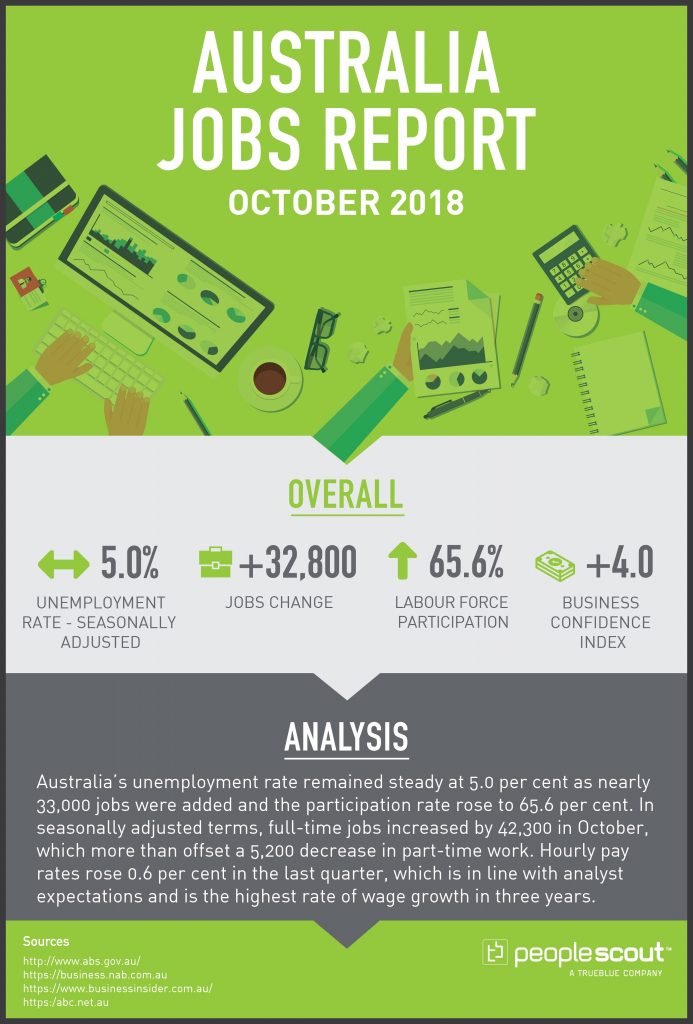The Australia Bureau of Statistics released its September Labour Force Key Statistics showing 5,600 jobs added to the economy and the lowest unemployment rate in more than six years.

The Numbers
5,600: The Australian economy added 5,600 jobs in August.
5.0%: The Australian unemployment rate fell to 5.0 per cent.
65.2%: Labour force participation fell to 65.2 per cent.
+6: According to the NAB, the business confidence index rose to +6 index points.
Upside
Australia’s unemployment rate fell to 5.0 per cent in September, the lowest rate since April 2012. The number of unemployed Australians decreased by 37,200 to 665,800, which is the lowest number since February 2013. The composition of the net change was an increase of 20,300 in full-time employment and a decrease of 14,700 for those in part-time employment. Since September 2017, full-time employment increased by 217,500 persons, while part-time employment increased by 63,400 persons. The Australian Business Confidence Index rose to +6.0 after falling to a two-year low in August.
In seasonally adjusted terms, the largest increase in employment was in Victoria (up 20,000 persons), followed by Western Australia (up 3,100 persons) and New South Wales (up 2,800 persons).
Downside
The small increase in overall employment was accompanied by a drop in the size of Australia’s labour force which fell from 65.7 per cent in August to 65.4 per cent in September. While this is still a relatively healthy percentage, not all Australians are reaping the benefits of the strong job market. The Sydney Morning Herald reports the following:
“Work in Australia is changing. People are working longer and retiring later. Some do this because they want to, but most do it because they have to.
Work is becoming more casual. For the first time, less than half of all Australians are in full-time work. About one in four are working casually. And as the economy changes, some jobs are disappearing altogether.
One group is bearing the brunt of these changes more than any other – people looking for low-skilled, entry-level jobs. Anglicare Australia’s Jobs Availability Snapshot, released on Thursday, shows what the job market is really like for this group. These are people who are looking for work, but who might not have education or recent work experience.
Our research shows two clear trends. First, low-skilled jobs have been drying up. The government’s own figures show that they have halved as a percentage of job advertisements since 2006. At the same time, more and more jobs are being aimed at people with advanced skills. In the month of our Snapshot, 39 percent of vacancies called for a degree or at least five years’ work experience.
And second, there are just not enough of these jobs for those who need them. We found that for every low-skilled job at the entry level, there are at least four job seekers who might be competing for them.”
Unknown
In its latest World Economic Outlook (WEO), the IMF said the global economy would grow 3.7 per cent this year, the same as in 2017 but down from the 3.9 per cent it was forecasting for 2018 in July. According to the report, Australia will hit 3.2 per cent growth this year before falling to 2.8 per cent next year. In April, the IMF was forecasting 2.9 per cent for Australia next year.
As the Australian Financial News reports “The downward revisions to the 2019 growth forecast for Australia and Korea relative to the April 2018 WEO partially reflect the negative effect of the recently introduced trade measures,” the IMF notes.” Without guaranties of stability with Australia’s major trading partners, the nation’s economic health including the strength of its job market, is far from certain.


